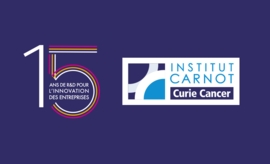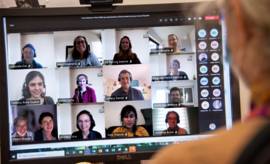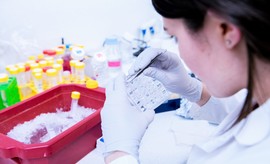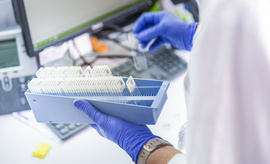Institut Curie: a catalyst for innovation with 101 inventors to its name
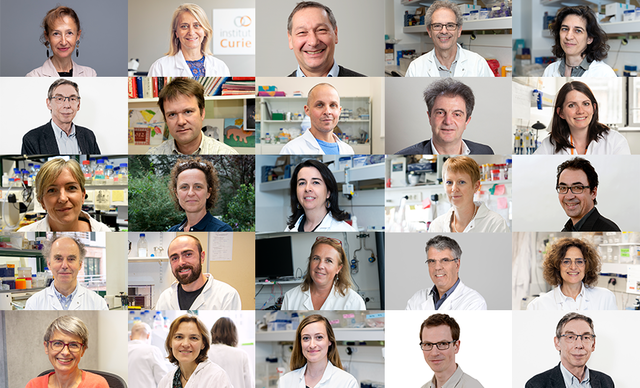
As of 2022, Institut Curie boasts 101 inventors among its staff. This resounding success points to Institut Curie’s high quality of research and care, and is the fruit of an ambitious strategy that was rolled out with a view to deepening the socio-economic value of its research – one of Institut Curie’s key objectives, backed by its Carnot Curie Cancer label[1].
What exactly does the term ‘inventor’ mean? The inventor is the designer of the invention. He is a natural person who has made an inventive contribution to the invention that is the subject of the patent application. Today, Institut Curie has a portfolio[2] of over 800 patents, with each inventor often having patented more than one invention.
Supporting inventors: from concept to exploitation
Thanks to a department dedicated to working closely with members of staff to support and encourage them in putting the findings from research or care activities to socio-economic use, Institut Curie is home to a number of inventors whose ranks continue to grow year after year, as Cécile Campagne, director of the Technology Transfer Office and Deputy Director of Carnot Curie Cancer explains:
We’re delighted by this ever-growing figure, which is made all the more gratifying in light of the innovation-fostering strategy that was adopted and is rolled out by a team of 18 people. At Institut Curie, our strength lies in a substantial investment in the earliest phases of technology transfer, namely the detection and maturation of inventions, in parallel with increased awareness and training of employees. We’re convinced this is instrumental in accelerating the process of getting these technologies to market and giving patients access to them: new cutting-edge technologies for improving cancer treatment, one of the biggest public health challenges for the next 30 years.
Success stories: three women, three Curie inventors
These 101 inventors from Institut Curie’s Research Center and Hospital Group have come up with breakthrough inventions across an array of fields: therapeutics, diagnostics, prediction, microfluidics and microbiological processes, to name but a few. And what’s more, despite the World Intellectual Property Organization’s statistics showing that just 17% of inventors named on patent applications are women[3], 50% of Curie’s inventors are female. Time for a closer look at the success stories behind three female inventors.
Isabelle Fromantin and her KDOG project: putting dogs to work in detecting breast cancer
First a nurse and then a researcher in the Wound and Healing Research Unit at Institut Curie, Isabelle Fromantin[4] is behind a unique medical innovation. Her KDOG project offers a new technique for early detection of breast cancer that is simple, inexpensive and non-invasive thanks to the sense of smell of dogs. Conceived in 2013, KDOG is now pursuing its development through a clinical study evaluating the dogs' ability to detect breast cancer. Institut Curie has just filed a new patent protecting the cones designed specifically for the testing methods integrated into the clinical trial. These cones contain the samples presented to the dog. Thanks to its training, the dog sits and remains static when it detects an "abnormal" odor.
In parallel, the KDOG COV translational study aims to determine the chemical signature of breast cancer in order to implement a new breast cancer screening technique based on odor analysis.
Clotilde Théry’s team: focusing on extracellular vesicles to fight triple negative breast cancer
The team "Extracellular vesicles, immune responses and cancer” (U932 Institut Curie/Inserm) led by Clotilde Théry, Inserm research director, recently and unexpectedly demonstrated for the very first time that extracellular vesicles of tumors induce macrophages that could boost anti-tumor responses. These findings were published in the PNAS journal on April 20, 2022 and are the subject of a patent filed by Institut Curie and Inserm.
Clotilde Théry’s team is now pursuing this promising work, paving the way for new more effective therapeutic solutions to fight triple negative breast cancer: cancer with a poor prognosis that affects around 15% of women with breast cancer.
30 years after the very first targeted therapies and 20 years after the emergence of immunotherapy, Institut Curie teams are now embarking on a turning point in oncology. For the very first time, they are seeking to target a specific cell population involved in cancerous processes (fibroblasts). Having won the Hospital-University Research scheme in 2021, the CASSIOPEIA clinical research project coordinated by Institut Curie and several industry partners has secured funding of €10m over a five-year period to deepen our understanding of triple negative breast cancer – particularly its heterogeneity – in order to identify patients likely to develop resistance to treatment immediately upon diagnosis. The end goal? To develop unprecedented therapies targeting fibroblasts, a type of cell that is abundant in tumors, although not yet targeted on a therapeutic level.
This work is patent-protected and is based on initial research from the team led by Fatima Mechta-Grigoriou, Inserm Research Director, head of Institut Curie “Stress and Cancer” team, and CASSIOPEIA’s coordinator.
[1] The Carnot label certifies excellence and is awarded to academic research institutes that demonstrate quality and engagement in partnership-based research. Institut Curie has been Carnot-labelled since 2011.
[2] A patent portfolio refers to all active patent categories that an entity may have, with each category containing multiple patents and/or patent applications.
[3] 2021 data.
[4] Team CEpiA, IMRB-UPEC/Inserm U955.




